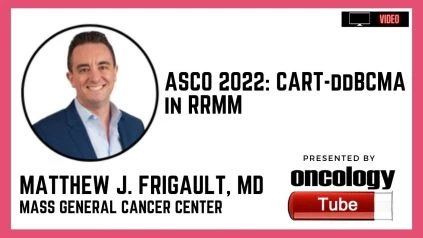Matthew J. Frigault, MD, Clinical Director- Cellular Immunotherapy Program at Mass General Cancer Center. In this video, he speaks about the ASCO 2022 Abstract – Phase 1 study of CART-ddBCMA in relapsed or refractory multiple myeloma.
Origins:
Chimeric Antigen Receptor (CAR) T cell treatments targeting B-cell maturation antigen (BCMA) have shown promise in individuals with relapsed or refractory Multiple Myeloma (RRMM). CART-ddBCMA is an autologous anti-BCMA CAR T cell treatment that employs a unique, synthetic binding domain known as a D-Domain rather than a traditional scFv binder. The goal of this first-in-human experiment is to evaluate CART-safety ddBCMA’s and efficacy.
Methodology:
This is a multi-center, open label, Phase 1 dose escalation trial for patients with RRMM who have had three prior treatments or are triple-refractory. Bridging therapy is permitted during manufacturing after apheresis. On days -5 to -3, patients receive fludarabine and cyclophosphamide (30/300 mg/m2/day) and a CART-ddBCMA infusion. Dose escalation was carried out at 100 (DL1) and 300 (DL2) x 106 ( 20%) CAR+T cells, followed by DL1 expansion. The primary endpoint is the occurrence of adverse events (AEs), which include dosing-limiting toxicities (DLTs). Depth and duration of response (IMWG Criteria), minimum residual disease (MRD, clonoSEQ), progression-free survival (PFS), and overall survival are additional goals (OS). Patients with one and three months of follow-up were considered for safety and effectiveness analyses, respectively.
Outcomes:
As of January 25, 2022, 25 patients had received CART-ddBCMA, with a median age of 66 (range: 44-76), following a median of 5 prior lines of therapy (3-16), including 10 (40%) with extramedullary illness (EMD). The median period of follow-up was 9.8 (2-23.7) months. Overall, 25 points (19 DL1; 6 DL2) were evaluable for safety, while 24 (18 DL1; 6 DL2) were evaluable for efficacy. CRS was encountered by all points, but only one point (in DL2) exhibited grade 3 CRS. All other CRS instances in DL1 were grade 2, with no incidences of grade 3 CRS. ICANS was encountered by four points (2, gr 2; 2, gr 3), with one gr 3 case in each of DL1 (5 percent) and DL2 (17 percent ). In all cases, standard care resulted in the remission of CRS/ICANS within 30 days with no sequelae. The ORR is 100%, the sCR/CR rate is 67%, and the VGPR rate is 88%. Conversion to CR/sCR has happened in this trial with prolonged follow-up, as late as month 9. At the time of data collection, 5 pts in DL1 with PR/VGPR had a 9-month follow-up, with 4 (of 4 evaluable) negative for MRD at 10-5. Overall, 17 of 20 (85%) evaluable points received the best MRD response of 10-5. Despite a 58 percent (7/12) EMD in the dose escalation group (those with the longest follow-up, n = 12), the ORR and CR/sCR rate were 100% and 75%, respectively. Four (67 percent) of the initial six patients dosed in DL1 remain in continuing sCR after 18 months, including three with EMD. Because 19 of 24 evaluable points (79 percent) remained in ongoing response, the median duration of response, PFS, and OS were not evaluable at the time of data-cut.
Observations:
To date, CART-ddBCMA administration has exhibited clinical action, including a 100 percent ORR with CR/sCR and VGPR rates of 67 percent and 88 percent, respectively. Long-term effects have been documented, even in patients with EMD. NCT04155749 is the clinical trial number.
More on this subject:
https://oncologytube.com/article/41519/ddbcma-multiple-myeloma—matthew-frigault-md—ash-2022-1?channelName=ash

